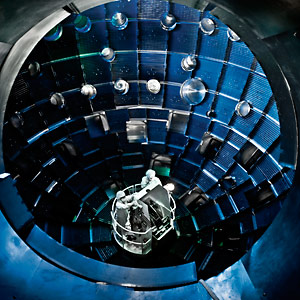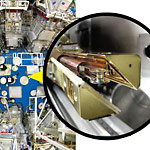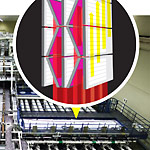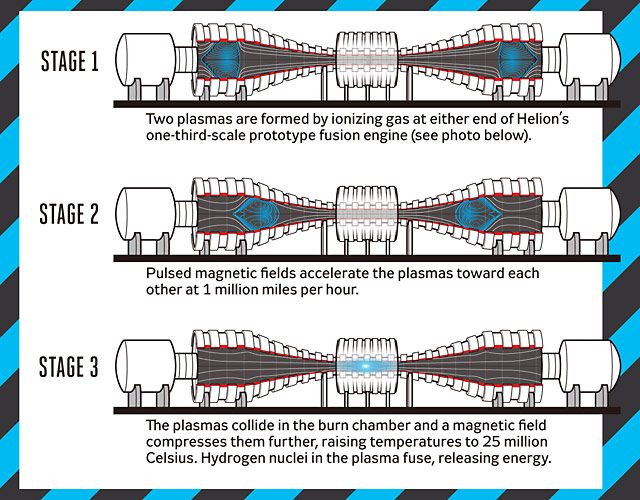From the other side of a wide glass window on the third story of the National Ignition Facility (NIF), the world’s largest laser array looks an awful lot like the world’s largest plumbing project. Row after row of 16-inch-diameter pipes are packed into a room like cigarettes in a box—only the box is the size of three football fields. A catwalk thick with miles of cable runs through the center. Large metal ducts snake overhead and along the walls. I have to take it on faith that the pipes, called beam tubes, don’t contain water or gas, but 192 separate laser beams zipping back and forth. When the beams finally exit the room, their strength amplified more than a quadrillion times, they will converge on a pencil-eraser-size target in one short, powerful pulse. And in those 20-billionths of a second, I’m told, atoms of hydrogen will smash together with such force that they’ll essentially create a star.

It sounds impressive—and certainly looks imposing—but society has been taking promises of fusion on faith for more than five decades. If fusion works as proponents claim, it could produce enough clean energy to power the world for hundreds and hundreds of years to come. One of the first hurdles is the tiniest component, the fuel: Hydrogen isotopes, such as deuterium and tritium, adamantly resist uniting, regardless of the amount of heat and steel and funding thrown into the effort.
But this past fall, physicists at NIF, based at Lawrence Livermore National Laboratory in California, made an important advance with their elaborate building and enormous laser: They fired 121 kilojoules of ultraviolet light into the $3.5 billion facility’s target chamber, causing deuterium and tritium nuclei to fuse into helium atoms, releasing 300 trillion high-energy neutrons. Even though NIF and other labs have created fusion before, the achievement brings researchers a step closer to conquering the ultimate challenge: a fusion reaction that produces more energy than is required to start it.
Expensive megaprograms such as NIF aren’t the only ventures making progress. At the other end of the funding spectrum, a number of innovative startups have also begun to yield promising results. After decades of frustratingly slow research, the emergence of real, practical fusion power may come down to a race between these entrepreneurial Davids and the government-run Goliaths.
Given the recent partial meltdown of reactors in Japan, finding public support for any form of nuclear energy might seem unlikely. Still, fusion has some important safety advantages over nuclear fission: To produce energy from fission, atoms such as uranium-235 are split into radioactive elements, some of which have extremely long half-lives. Nuclear fusion produces helium and neutrons, and no super-long-lived radioactive waste. Plus, fusion cannot cause runaway reactions because it requires a steady input of energy for the isotopes to fuse; any plant malfunction would cause near-immediate shutdown. Over the long term, fusion power might reduce pressure on fossil fuels such as oil and coal, while complementing clean but intermittent energy sources such as wind and solar.
To produce electricity, the heat generated during a fusion reaction could be harnessed to drive a steam turbine, just as in any power plant. The difference is that fusion doesn’t rely on the trainloads of coal, shipments of uranium, oil and gas drilling rigs or elaborate pipelines that feed today’s facilities. Deuterium is found in seawater. “See those two water jugs right there?” says Edward Moses, the director of NIF, pointing to a display in the facility’s atrium. “Those would have the energy equivalent of a supertanker of oil.”
Fusion from the World’s Biggest Laser
At the National Ignition Facility (NIF), “inertial confinement fusion” begins with a very small, weak laser pulse. This pulse is split into 48 beams and sent to preamplifiers, which increase the energy to a few joules. The laser is split further into 192 beams and injected into beamlines that enter two massive bays. The beams then pass through two systems of glass amplifiers, which increase their power to 20,000 joules. After leaving the main laser building, the parallel beams are rearranged into a spherical configuration by mirrors in 10-story-tall “switchyards.” A final optics assembly converts the lasers’ wavelength from infrared to ultraviolet, and a lens focuses them on a precise target in the center of a chamber.

Target Chamber
NIF’s target chamber contains the fuel for fusion: a dime-size gold cylinder, called a hohlraum, encasing a beryllium-coated capsule with deuterium and tritium atoms. When lasers strike the hohlraum, their energy is converted to X-rays that burn away the capsule, compressing the fuel and forcing it to implode.

Amplifiers
A system of amplifiers (shown in the laser bay) provides 99.99 percent of NIF’s power. Vertical arrays of flash lamps excite neodymium atoms embedded in slabs of phosphate glass. As lasers pulse through the glass, they pick up that energy.
At the modest headquarters of Helion Energy in Redmond, Wash., the off-Broadway equivalent of the colossal NIF production is beginning to play out. The company is tucked away at the back of a nondescript suburban office park in a space not much bigger than a dentist’s office; if you weren’t specifically looking for Helion, you’d never come across it. A reception desk near the entrance has been repurposed into a workbench strewn with electronic components. Colored cables dangle overhead in free-form clusters, and workstations are propped up with cinder blocks. At one point, the researchers talk about a 10-tesla coil they’re working on to amp up the strength of their reactor’s magnetic field. “We built that coil,” scientist George Votroubek says. “Have you showed her yet?” “No,” his colleague Chris Pihl replies casually, “it’s on the front counter.”
Helion is among a handful of fusion startups, such as Tri Alpha Energy in Foothill Ranch, Calif., and General Fusion in Vancouver, British Columbia, all striving for the same grand goal as their outsize government counterparts: remaking the global energy landscape by proving that fusion power is feasible. A few forward-looking venture-capital firms have provided funding to get them off the ground; Tri Alpha, for instance, has attracted more than $50 million from a variety of prominent firms, including Goldman Sachs and Vulcan Capital.
Helion’s technology was developed for about $5 million by MSNW, a company owned by University of Washington research associate professor John Slough. To see a full-scale component of the reactor, which Slough calls a fusion engine, I meet him at an industrial building a few minutes’ drive from Helion’s headquarters and walk past a conference table to a room filled with giant metal parts.
Inside the 26-foot-long prototype, two plasmas—clouds of hot ionized gas containing hydrogen isotopes—hurtle toward each other. The clouds collide inside a burn chamber, merging into a single entity. An electromagnet surrounding the chamber squeezes the plasma tighter and tighter, creating the high temperature and pressure conditions needed for fusion—a milestone MSNW first passed in 2008. “The idea,” says Slough, who has the white hair and slightly disheveled appearance of a modern-day Einstein, “is to have the energy that comes out of the plasma exceed the energy that goes into it for a brief period of time.”
Management Information Services senior energy adviser Robert Hirsch, a former director at the U.S. Atomic Energy Commission, argues that startup companies may have some surprising advantages. Forced by funding constraints to design systems that are as simple as possible, startups are likely to end up with clean, lean reactors instead of complex, monolithic ones, like NIF’s, which have the potential to fail in dozens of different ways. “If you’re going to build a successful fusion system, it’s going to be inherently small,” Hirsch says. With a scaled-back approach, “there is a good chance they could make something that works.”
The team announces that they’re about to show me exactly what Helion-style fusion looks like. “You might want hearing protection for this,” the company’s president, Philip Wallace, says, handing me a pair of industrial-strength earmuffs. His colleagues power up the device. After the countdown clock on someone’s iPhone drains to zero, there’s a burst that sounds like a bulb breaking and a flash of pink light so bright that I have to turn away for a second. Wallace turns to me triumphantly: “You just witnessed fusion.”
The idea of generating power from fusion has captured scientists’ imaginations ever since U.S. physicist Edward Teller developed the first fusion-based hydrogen bomb, which released hundreds of times more energy than a fission bomb, in 1952. (Hot-fusion-powered approaches to creating energy are completely different from discredited “cold fusion” experiments, in which a current is passed through an electrode in heavy water in an attempt to coax nuclei to combine.) But in early tests of fusion, plasma leaked out of the confinement zone inside reactors faster than scientists had predicted, scuttling fusion reactions before they could occur.
Fusion’s prospects seemed to improve in the 1960s, when scientists in the Soviet Union tested a new type of fusion reactor called the tokamak. It featured a doughnut-shaped, electrically generated magnetic field that kept the plasma confined. Most international fusion research to date has followed the tokamak model; experimental tokamak reactors such as the United Kingdom’s Joint European Torus (JET) and Japan’s JT-60 have helped scientists understand how to confine and handle fusion plasmas. Leveraging this knowledge, 34 nations are collaborating to build the world’s largest tokamak, called ITER, a demonstration project tentatively slated to start operation in France in 2019.
NIF scientists have taken a completely different approach. Instead of undertaking the delicate task of confining plasma inside a magnetic field, they aim to produce a controlled version of the fusion that takes place inside the sun or a hydrogen bomb, using lasers as the reaction’s driver—a technique called inertial confinement fusion. NIF’s Moses notes that many of the building blocks of the project’s massive laser array have already been used successfully in other industrial settings: Laser diodes similar to NIF’s have enabled fiberoptic data transmission in the telecommunications industry for years. “It’s a good place to be when you’re riding the wave of other people’s work,” he says.
With its pulsed magnetic field design, the Helion team claims it has found the elusive sweet spot in the fusion landscape: a reliable, cheap reactor that doesn’t require fine-tuned optics or complicated plasma confinement. In Helion’s reactor, electric currents flowing inside the plasma reverse the direction of a magnetic field that’s applied from the outside; the new, closed field that results effectively confines the plasma. “Compared to the tokamak and NIF, Helion’s reactor is relatively compact and low-cost,” says Richard Milroy, a physicist at the University of Washington who isn’t affiliated with Helion. “Utilities don’t need to invest billions for the first test reactor to see if things will work out.” Plus, he says, the plasma-formation area is separate from the burn chamber in Helion’s reactor, so its expensive components may last longer.
Still, all of these experimental fusion approaches face a host of scientific and practical unknowns. The massive numbers of neutrons generated during fusion may damage components of a tokamak over time, and the plasma inside can also become unstable, impeding the reaction. And even though NIF has managed to achieve partial fusion by firing individual rounds into its target chamber, similar lasers would likely need to fire 10 to 15 times every second in LIFE, the demonstration power plant Lawrence Livermore is designing for the early 2020s. That kind of consistent firing would require a laser driver with a high repetition rate, which has yet to be developed and tested.
While Helion’s reactor is much simpler than those of ITER or NIF, it’s also not yet powerful enough to be useful to a utility. Slough says his team will need to increase the size of the reactor’s magnetic confinement field and boost the acceleration rate so that the plasmas will be traveling about twice as fast by the time they crash into each other. Those refinements will require at least $15 million to $20 million in development costs, money Helion does not currently have. Even if the funds materialize, there’s no guarantee the reactor will work as projected when scaled up, or function consistently over long periods of time.
Wallace has traveled all over the U.S. and Europe, trying to secure money for this next phase, but, so far, firms haven’t seemed interested in bankrolling a company that may take a quarter-century to start making reliable power. “Nobody’s said they don’t believe our science, but it’s a struggle,” he says. “We believe we’re a long way ahead, but we’re also not close to the finishing line.”
Fusion from Plasmas Colliding in a Living-Room-Size Engine Surrounded by Magnets

The fusion reactor licensed by startup Helion Energy features a field-reversed configuration, in which a closed magnetic field created by electric currents inside plasma—hot ionized gas containing hydrogen atoms—keeps the plasma confined. The magnetic field also captures high-energy helium ions created during the fusion reaction, replenishing some of the energy used to start the reaction.
Focusing on fusion’s feasibility sidesteps a question that’s perhaps more crucial: whether we should be pursuing fusion energy at all. For every optimist, there’s at least one expert who believes fusion will never become a commercial reality. “One aspect that gets underestimated is the great challenge of converting the energy of fusion into useful electricity,” says David LeBlanc, a physicist at Canada’s Carleton University. Even when fusion reactions are successful, it’ll be a very tall order to get past the fabled break-even point and create a fusion reaction that produces more energy than is needed to start it—and until that is achieved, pure fusion power is just a lab experiment.
Some observers think we’d be better off scrapping fusion altogether. “These technologies are a luxury we cannot afford,” says Thomas Cochran, a senior scientist in the nuclear program at the Natural Resources Defense Council. “It’s hard to see how you get from here to commercialization in any cost-effective manner.” Alternative energy, on the other hand, can be deployed today: Wind and solar have essentially come to technological fruition, and money spent installing turbines and arrays would immediately begin to offset carbon emissions.
Even fusion’s more ardent supporters agree that—given the technical issues plaguing each fusion approach and the high cost of building prototypes—it is still many years from reaching the point of adoption. “In the long run, it will be a winner. We just don’t know when that time frame will be,” says Stephen Dean, president of the nonprofit research firm Fusion Power Associates. “If we had a crash program, like the moon or the atom bomb project, we could do it in 15 to 20 years, but that’s the most optimistic thing I can think of.”
Other researchers say fusion might be most useful—at least in the near term—as a means of destroying waste from nuclear fission. University of Texas physicist Swadesh Mahajan and his colleagues are developing a hybrid fusion–fission reactor that shunts neutrons produced during fusion to a fission blanket that burns nuclear waste as fuel. “Producing energy by fusion is at best a very long-term project,” Mahajan says, “but through this intermediary, we can become useful to the energy sector.”
NIF’s projected LIFE power plant will be designed to burn waste, too, and Helion is considering adapting its reactor to do the same in order to provide revenue from utilities sooner. It’s easier from a technical standpoint than using fusion to produce energy, because achieving break-even is not necessary—and it could potentially help solve a long-standing problem. Using Sandia National Laboratories data, Helion calculates 50 fusion engines could incinerate the entire U.S. stockpile of nuclear waste in 20 years.
Regardless of the detours fusion may take, its backers remain determined to see their initial energy quest through to its completion. Both Moses and Wallace insist that fusion power is a key component of a sustainable global future. “When you have a chance to do something that’s meaningful, you might as well go for it,” Wallace says. “It’s not just making another widget.” If they pull it off, it will be more like engineering the seemingly unattainable: the ultimate solar energy, a plant that manufactures the power of the sun.

 Follow
Follow